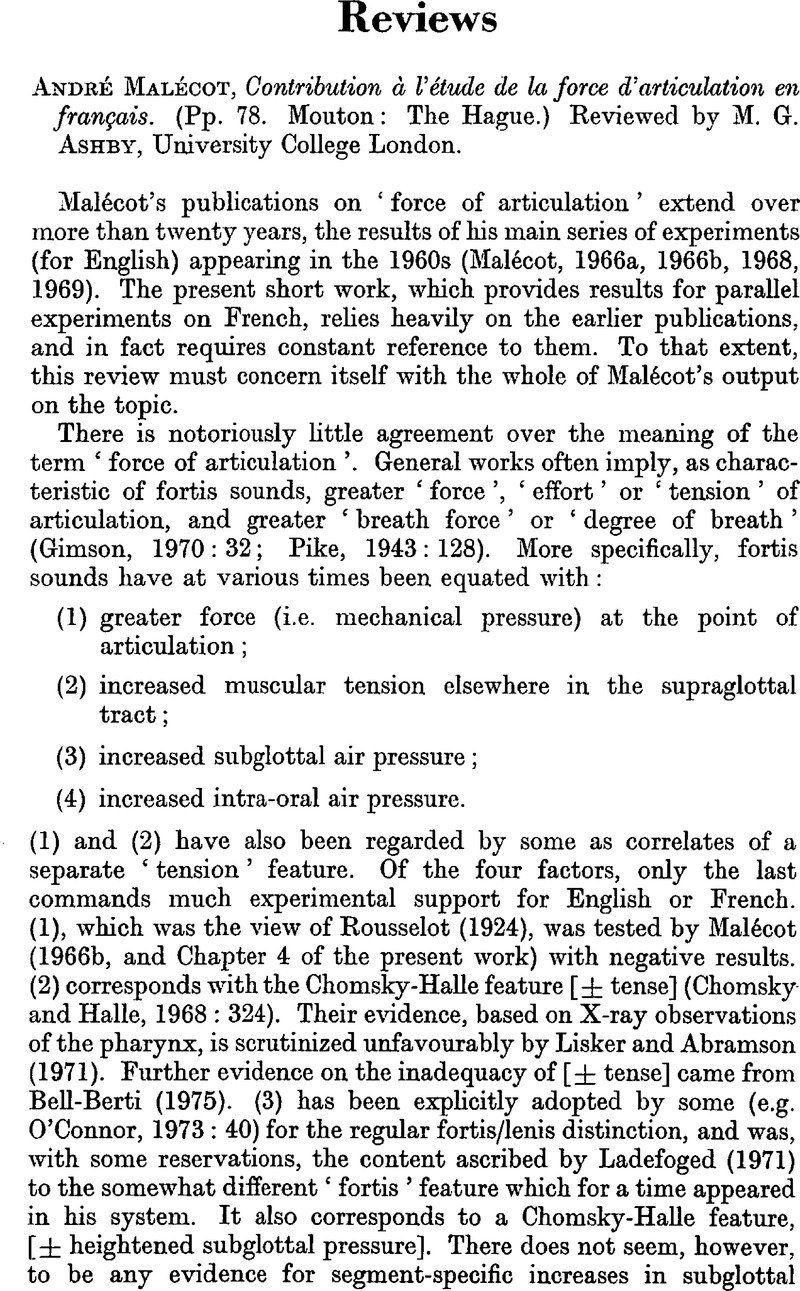No CrossRef data available.
Article contents
André Malécot, Contribution à l'étude de la force d'articulation en français. (Pp. 78. Mouton: The Hague.)
Published online by Cambridge University Press: 06 February 2009
Abstract
An abstract is not available for this content so a preview has been provided. Please use the Get access link above for information on how to access this content.

- Type
- Reviews
- Information
- Journal of the International Phonetic Association , Volume 9 , Issue 2 , December 1979 , pp. 74 - 80
- Copyright
- Copyright © Journal of the International Phonetic Association 1979
References
Arkebauer, H. J., Hixon, T. J., and Hardy, J. C. (1967). ‘Peak intraoral air pressures during speech’, Journal of Speech and Hearing Research, 10: 196–208.Google Scholar
Bell-Berti, F. (1975). ‘Control of pharyngeal cavity size for English voiced and voiceless stops’, Journal of the Acoustical Society of America, 57: 456–61.Google Scholar
Bendor-Samuel, J. T., and Spreda, K. W. (1969). ‘Fortis articulation: a feature of the present continuous verb in Agbo’, Linguistics, 52: 20–6.Google Scholar
Chomsky, N., and Halle, M. (1968). The Sound Pattern of English. New York: Harper and Row.Google Scholar
Daniloff, R. G. (1973). ‘Ease of articulation: conflicting results’, Journal of Speech and Hearing Research, 16: 753.Google Scholar
Gimson, A. C. (1970). An Introduction to the Pronunciation of English, 2nd edn.London: Arnold.Google Scholar
Greenberg, J. H., and Jenkins, J. J. (1964). ‘Studies in the psychological correlates of the sound system of American English’, Word, 20: 157–77.CrossRefGoogle Scholar
Ladefoged, P. (1971). Preliminaries to Linguistic Phonetics. Chicago: University of Chicago Press.Google Scholar
Lisker, L. (1970). ‘Supraglottal air pressure in the production of English stops’, Language and Speech, 13: 215–30.Google Scholar
Lisker, L., and Abramson, A. S. (1971). ‘Distinctive features and laryngeal control’, Language, 47: 767–85.Google Scholar
Locke, J. L. (1972). ‘Ease of articulation’, Journal of Speech and Hearing Research, 15: 194–200.Google Scholar
Malécot, A. (1955). ‘An experimental study of force of articulation’, Studia Linguistica, 9: 35–44.Google Scholar
Malécot, A. (1966 a). ‘The effectiveness of air-pressure-pulse parameters in distinguishing between stop cognates’, Phonetica, 14: 65–81.Google Scholar
Malécot, A. (1966 b). ‘Mechanical pressure as an index of “Force of articulation”’, Phonetica, 14: 169–80.Google Scholar
Malécot, A. (1968). ‘The force of articulation of American stops and fricatives as a function of position’, Phonetica, 18: 95–102.Google Scholar
Malécot, A. (1969). ‘The effect of syllabic rate and loudness on the force of articulation of American stops and fricatives’, Phonetica, 19: 205–16.CrossRefGoogle Scholar
Malécot, A. (1970). ‘The lenis-fortis opposition: its physiological parameters’, Journal of the Acoustical Society of America, 47: 1588–92.Google Scholar
Malécot, A., and Peebles, K. (1965). ‘An optical device for recording glottal adduction-abduction’, Zeitschrift für Phonetik, 18: 545–50.Google Scholar
Parnell, M., and Amerman, J. D. (1977). ‘Subjective evaluation of articulatory effort’, Journal of Speech and Hearing Research, 20: 644–52.Google Scholar




